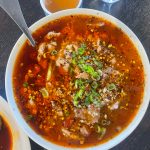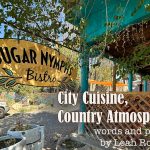
In the world of spirits, gin is unique. No other distilled liquor is crafted with botanical aromatics in the way gin is. For gin to be gin, it must contain juniper, but in virtually all gin, other aromatics round out the bouquet—citrus, spices, herbs, leaves, twigs, bark, roots, fruits, flowers, even resins. The traditions that coalesced into what we know today as gin go back to the Middle Ages and beyond, when the line between a tipple and a medicine was far less distinct. It’s likely that gin’s earliest ancestors were strong, dark, bitter concoctions intended as medicines to employ juniper’s distinct anti-inflammatory qualities; it’s equally likely that they were also consumed recreationally, the juniper effectively masking the alcohol’s foul taste.
Gin enjoyed its first flush of respectable popularity only after the mechanics of column distillation were worked out in England in the early 1800s. Later that century, the “London dry” style was established to distinguish itself from its lower-class predecessors; it’s still the best-selling style of gin. In the 1950s and ’60s, gin was the chief clear spirit in the bartender’s speed rail; vodka was still on the rise and tequila was still exotic to most American palates. When gin is shaken, some of the juniper and other delicate aromas dissipate, leaving a more neutral-tasting spirit. You can find gin in all manner of sweet shaken drinks in midcentury bar manuals, and when you taste them, you barely taste gin.
From the 1960s through the 1990s, as vodka and tequila made their long, gradual ascent to bar-world dominance, and as American wine exploded in quantity and quality, gin’s reputation languished. But as longtime New York Times food critic Pete Wells wrote in 2015, “gin never really went away: it merely stumbled into the bedroom and passed out on a pile of coats.”
Starting about twenty-five years ago, the concept of “terroir,” or sense of place, long used in the wine world, began to gain currency in the culinary and cocktail worlds. The idea was soon applied to the crafting of gin, and so began what some have called the “ginnaissance.” All around the globe, distillers began making gins that reflected their unique terroir: the characteristics of the place where they were made. One of the first to emerge was in fact called Terroir, released in 2011 by the St. George distillery in Alameda, California. Terroir gin was inspired by St. George master distiller Lance Winters’s time hiking on Mount Tamalpais in Marin County, north of San Francisco. On those trails, you walk among California bay, Douglas fir, and juniper trees, their scents hanging in the air. Winters crafted a gin that captures those aromas—and perhaps that experience—in the bottle. Terroir has a “green” aromatic profile like no other. It helped redefine what gin is and can be.

Gin was not on the horizon when Penny Rembe mixed the first batch of lavender salve at Los Poblanos Historic Inn & Organic Farm in 1999. New Mexico’s farm-to-table movement was still young, and her husband and business partner, Dr. Armin Rembe, had only recently begun growing lavender on the property they’d purchased twenty years earlier in Los Ranchos de Albuquerque. Today, Los Poblanos’ lavender fields, along with their boutique inn and spa; their farm-to-table restaurant, Campo; and their body products—many featuring distillates of lavender and other farm botanicals—are famous throughout the state and beyond. And the business might have sailed along indefinitely, operating within the idyllic constraints of its flagship location, were it not for their decision to add another craft elixir to their portfolio—a decision that came about, indirectly, because of the COVID-19 pandemic.
“Hospitality was shut down, and a mass gathering couldn’t exceed five people,” said executive director Matt Rembe (son of Penny and Armin), recalling the upheaval of that moment. “At weddings you couldn’t even have both sets of parents. We had several million dollars of deposits down, and people were calling daily for months, asking, ‘How are we going to do my wedding? What are you going to do about us being able to dance? How close can we get?’”
As we sipped gin at his kitchen table, Matt told me that he’d quickly realized they needed to start issuing refunds—and he worried about being able to keep on the hospitality staff while everything was shut down. But simultaneously, Los Poblanos’ product business began to take off; they sold $150,000 of lavender hand sanitizer in a few hours. The push to stay resilient during restaurant and hotel closures led them to search for a new warehouse, where they could expand their product business. “We were looking at all these different warehouses—they’re all windowless, horrible places,” Matt said. “It just didn’t feel like us.” That’s when they found the historic Town & Ranch building in downtown Albuquerque, a large, open warehouse with skylights and potential retail space in the front. The catch: it was far more expensive than they could justify for making lavender products.
Matt began to wonder about making and manufacturing gin—after all, distillation of botanicals had long been a part of Los Poblanos. “Gin made sense because of all the botanicals—all those expressions of the gardens and the fields and the Rio Grande River Valley. Can we throw something in there that’s from the Southwest, that’s from New Mexico, that’s from Los Poblanos, that’s evocative of our place?”

In late 2021, Matt assembled a small “gin team” that included two of Los Poblanos’ longest-term employees: Dylan Storment, now the director of wine and spirits, and Jamie Lord, then botanical distiller for their product line. Jamie, an Albuquerque native, had learned the art of botanical distillation from Matt’s father, Armin, in the mid-2010s. To help her gain some background for the project, they sent her to a gin-specific course at the renowned Moonshine University in Louisville, Kentucky.
“She was this great plant distiller,” Matt said of Jamie, “homegrown, just like Dylan, and when we were thinking of doing the gin, I talked to some people: ‘Does she need to know liquor distillation, if she already knows plant distillation?’ And they were like, ‘That’s so cool, nobody’s ever asked us that—everybody else just comes from the liquor industry or the brewing industry, so to have someone who comes purely from the botanical side is just fascinating.’”

While gin can be made via “cold compounding,” where neutral spirits are mixed or infused with botanicals, a quality gin’s aromas and flavors are imparted via distillation. To qualify as “London dry” style, botanicals must be distilled or redistilled with the spirit, and all of the gin’s flavor must be from natural, botanical sources. London dry’s aromatic profile—bold juniper front and center, with citrus and other botanicals playing supporting roles—was the model for almost all gin for decades. The new styles that have come onto the market over the past twenty-five years, many of which explore the idea of terroir by pulling the juniper back and bringing other aromatics forward, were eventually dubbed “new western.”
When I met with Dylan at the bar at Campo to talk about gin, he said, “We wanted to create a product that exemplified New Mexico to us—these aromas or these botanicals are what make us feel like this is New Mexico . . . not just New Mexico, but Los Poblanos and the Rio Grande Valley. And with the new western–style gin, it gave us the opportunity to do something different.”
The first stage of developing their gin, Matt said, was tasting other gins and identifying what made them unique. “Dylan started ordering all these craft gins, including London drys, and we just would taste stuff. . . . What really made the light bulb go off with the new western style and sense of place were the Japanese gins. You tasted yuzu, you tasted cherry blossoms.”
Dylan said, “At some point we [wondered], because none of us had ever done this before—what are the components? Is there such a thing as a gin ‘flavor wheel’? And there was! So that really led to us to take some of the ideas from this generic pathway, and start plugging in our own ideas—what botanicals speak more to New Mexico but maybe are similar. So that really did help us. We ended up making our own gin wheel—it was really fun.”
That process also helped the team decide on a base spirit for the gin. While most gins employ a grain base, they originally wanted to use a base spirit made from sugar beets, as they were grown at Los Poblanos during World War II when there was a sugar shortage. But they weren’t able to source sugar beet base, so they turned to sugarcane. “For the mouthfeel, that’s why we ended up with the cane,” Matt said. “The Japanese gins and others had this velvety quality we all liked—they just glide, like a nice wine.”

Early on, they realized they would be making two gins: a botanical-driven new western style and a lavender-distilled gin. I met with Jamie while she was making gin at the distillery, housed (along with a speakeasy-style bar and tasting room) in the capacious Town & Ranch building on Fourth Street, and she told me she’d produced about ten iterations of each gin over the course of the tasting process.
“The lavender one was funny because at the tasting meetings, I kept thinking, I don’t want to go too far, because my teacher at Moonshine University was like, ‘Bleh—lavender in gin tastes like soap—you shouldn’t put more than .5 percent in any product.’ And I thought, well, maybe they just aren’t familiar with culinary lavenders, and they don’t know, so I kept adding it very gingerly to the recipes,” she said. “But the tasting team kept saying there needed to be more lavender, so then I went way farther than I originally wanted to, and I brought it to one of the tasting meetings, and I thought, this is it—this is the one I nailed. Everybody tasted it and they were like, ‘This is really good . . . but what if we doubled the lavender? ’ So I did, and they were like, Perfect! When we first made them, I was all in on the Western Dry—it was my baby. But now that I’ve been tasting them for two years, I’d be hard pressed to pick a favorite—the Lavender is getting up there. And people really love it.”
But the first batch, she said, “was just trying to make really standard gin . . . something junipery.” At that point, she was making it in a 1-liter alembic, one bottle at a time. “And then I just did a ton of research. I started walking the property at Los Poblanos, seeing what we had, what I thought was interesting,” she said. “I knew I wanted to use hawthorn berries right away, we just had so many of them. I came to know hawthorn in my studies of herbalism—they’re really good for heart stuff, for people who have heart palpitations or high blood pressure or things like that, but also spiritually—if you manifest anxiety in your heart space, hawthorn is good for that too. It’s kind of . . . like a pithy crab apple; it adds a little bit of sweetness and a little bit of tartness.”

The gin team soon brought in members of the Los Poblanos marketing group, and they discussed the bottle, and decided the gin’s label would be a reproduction of the 1934 signature tile that architect John Gaw Meem placed on Los Poblanos’ historic La Quinta house, depicting a gentleman farmer, meant to represent San Ysidro, the patron saint of farmers, standing between his cornfields and his cows.
Both gins were released in late 2022. The Western Dry is made with sixteen aromatics, including juniper, rose, lavender, and piñon. The Lavender Gin is made with most of those same aromatics, but in different proportions, and with much more lavender. To say they are delicious is barely scratching the surface—they are uniquely aromatic, complex, well balanced, and very different from each other.

I’ll always remember my first undistracted sip of the Western Dry: I immediately had the sensation, without “reaching” for it, that it tasted like New Mexico and Los Poblanos. It has a beautiful range of aromas—juniper is present, but subtle, and where it leaves off, the woodsy aroma of piñon comes in, an unmistakably New Mexican touch. Jamie says, about the piñon, “It’s really weird, right? It softens the alcohol, I think—it kind of smooths it out. Things that are resinous do that with alcohol—they make it coat your tongue in a less fiery way. The oils of the juniper and the oils of the piñon become one.” There is very subtle lavender, augmented by other florals. There are herbal aromas, perhaps from the rare herb angelica. There is citrus, but mostly from lemon verbena and lemongrass. Jamie says, “I wanted a citrus component but I didn’t really want to use citrus peels; I just thought they were kind of harsh. There is a teeny tiny bit of orange peel. But Christa Obuchowski, our fragrance partner, suggested lemon verbena and I fell completely in love with it. I thought it smelled like lemon custard.”

The Lavender Gin’s legal name is “Gin Made with Lavender” because “lavender gin” would indicate a flavored gin: a gin infused with lavender, post-distillation. Instead, the lavender is distilled in the gin. Matt claims that it is the only gin on the market that employs more than one cultivar of lavender—and in fact, there are four: Royal Velvet, Provence, Munstead, and Buena Vista. Although this gin is, as Dylan expressed the team’s goal, “like a big bunch of lavender,” it is beautifully balanced. Florals including rose, viola, and chamomile complement the lavender. Juniper and piñon notes are there, but far in the background. It carries the sweet floral component of lavender, but none of its camphoraceous qualities. It holds its place among unique gins, and it’s fitting that the craft gin movement was beginning around the same time that Los Poblanos first planted lavender.

Los Poblanos’ Western Dry Gin was named one of the nation’s best craft gins in 2023 by USA Today, and—even more remarkably, given that it was head distiller Jamie Lord’s first spirit and first gin—it won a Double Gold award in the 2024 Bartender Spirits Awards, a worldwide competition. Bartenders embrace the Western Dry, while retail sales of the Lavender Gin have been excellent: “It’s turning the heads of people who typically don’t like gin,” says Matt.
Leveraging the success of the gin, Los Poblanos has a few new projects in the works, from barrel-aging Western Dry in barrels from distilleries they love to developing a line of bitters to thoughts of absinthe. But their pride in the gin they created is both justified and evident. Dylan says, “To be able to show the sense of place is really important, and I think—I hope—that what we accomplished is bringing the spirit of Los Poblanos into the bottle.”
📍Town & Ranch, 1318 Fourth St, Albuquerque, 505-808-1715
📍Bar Norte, 201 Washington Ave, Santa Fe, 505-808-1713
For much of the past year, Tom Hudgens worked as the event chef at Los Poblanos. Here, he shares some of the fruits of his labor: “Two Gin Cocktails and a Gin Liver Crostini.” Tip: if you don’t drink, skip to the pickled mulberries and pâté.

Tom Hudgens
Tom Hudgens has followed multiple career tracks over the decades, including writing, professional cooking, and college academic support. The author of The Commonsense Kitchen and The Deep Springs Cookbook, he recently worked as Los Poblanos’ event chef, writing menus, toiling away with his team in the Campo and La Quinta kitchens, and creating delicious food for weddings, retreats, and other events. He now works as a donor engagement officer at the University of New Mexico Foundation, and cooks dinner at home from scratch almost every night.








